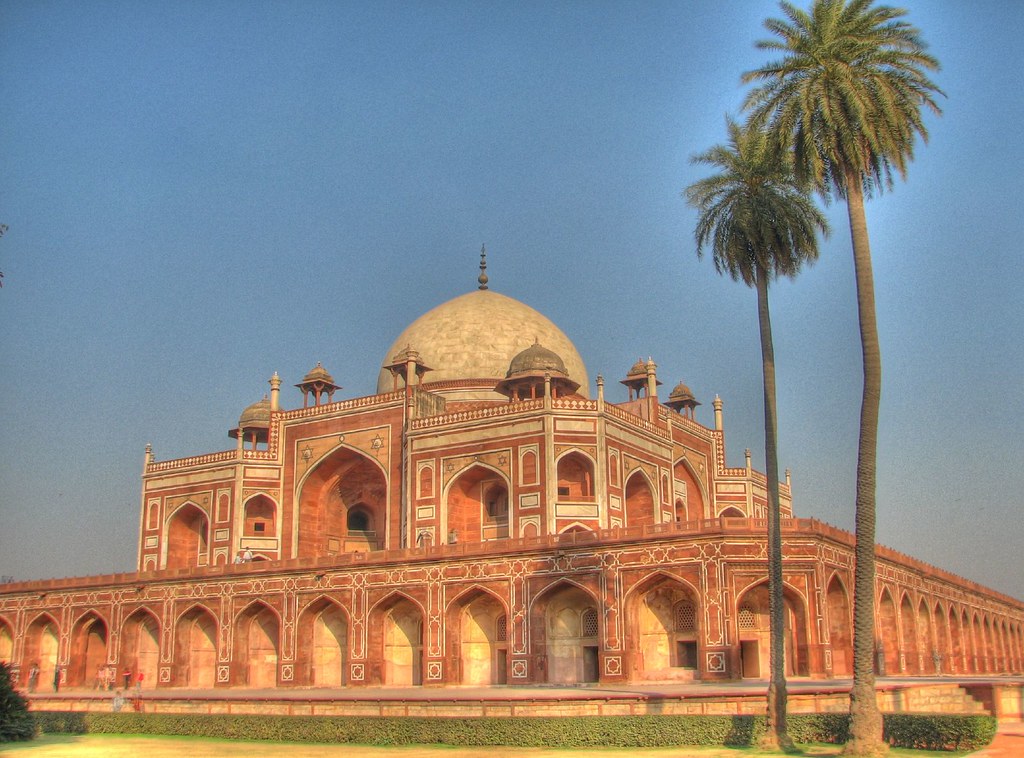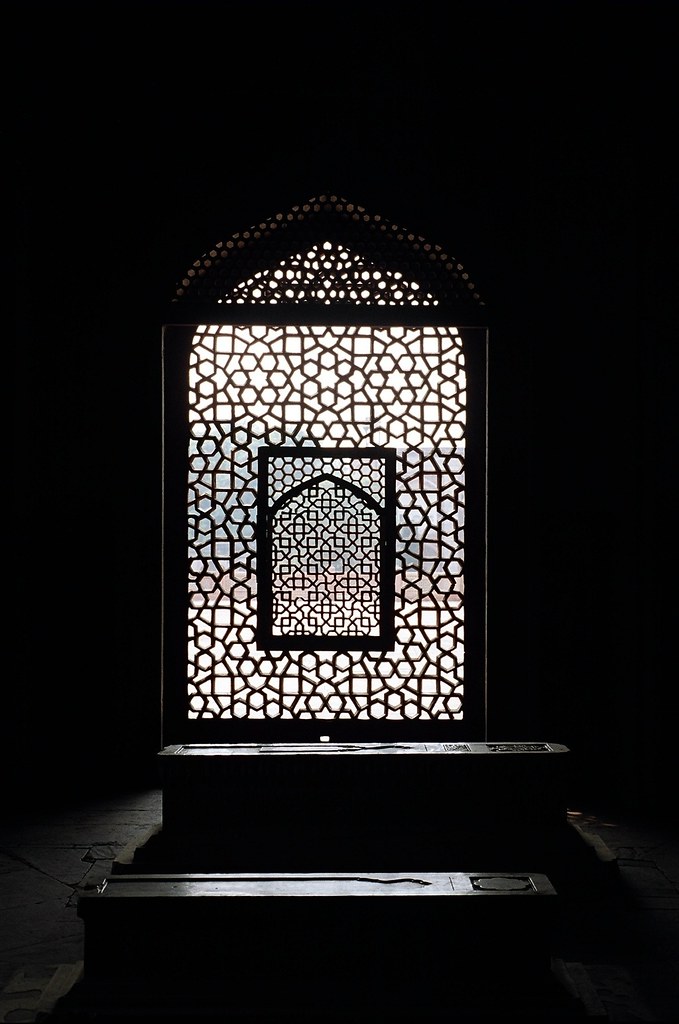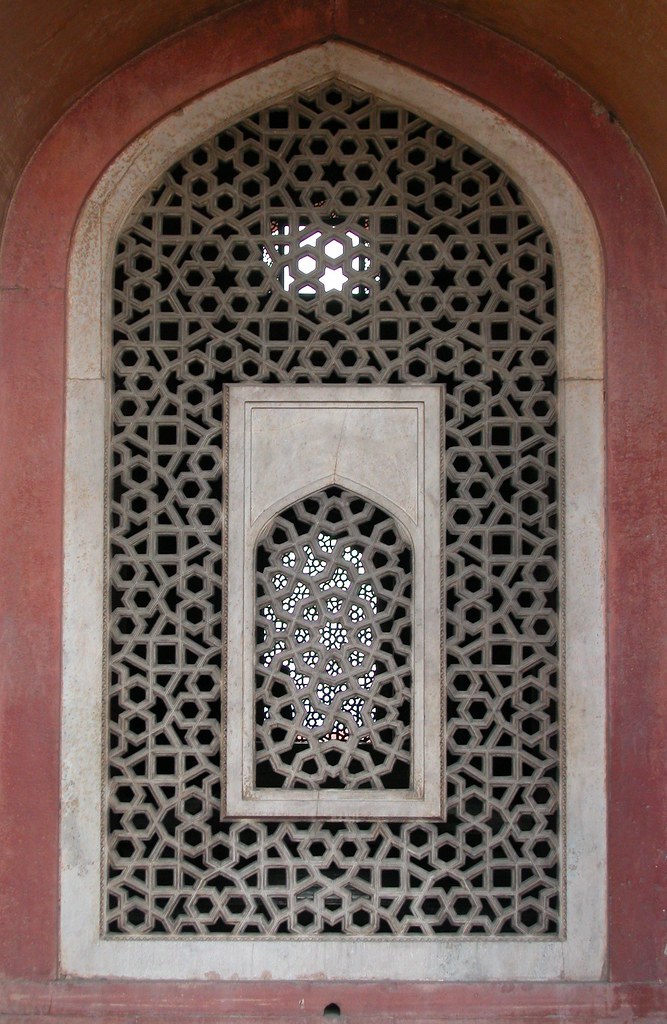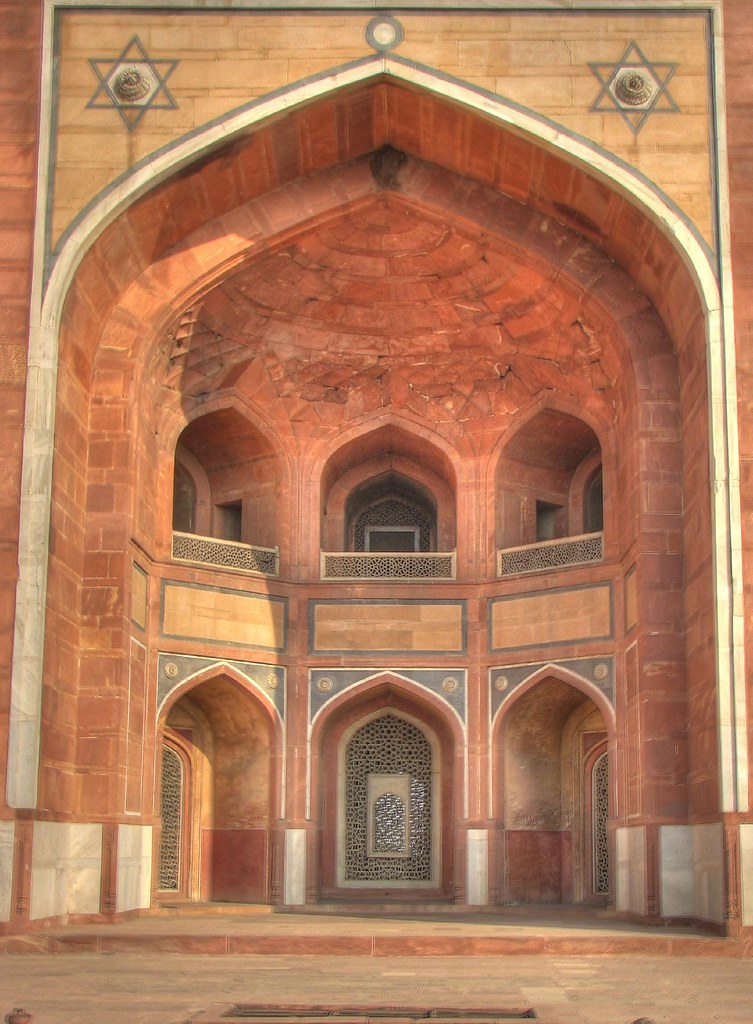.

Mausoleum and funerary gardens of the Second Mughai Emperor Humayun, Delhi, in 1820. Watercolour in Agra style by Delhi artist. Inscribed on front in English: 'Tomb of Hoomauyoon Bad Shah';' Tomb of Koaka'; in Persian characters: Maqbarah i Kokah -- Maqbarah i Humayun badshah i ghazi (Tomb of Kokah -- Tomb of the Emperor Humayun): artist unknown, 1820 (British Library)
Contra the debate of wasps
the dialectic of apes
the chirping of statistics
it proposes
..................(lofty rose flame
built of stone and air and birds
time in repose above water)
the architecture of silence.
Al debate de las avispas
la dialéctica de los monos
gorjeos de las estadísticas
opone
........(alta llama rosa
hecha de piedra y aire y pájaros
tiempo en reposo sobre el agua)
la dialéctica de los monos
gorjeos de las estadísticas
opone
........(alta llama rosa
hecha de piedra y aire y pájaros
tiempo en reposo sobre el agua)
la arquitectura del silencio.
Octavio Paz (1914-1998): El Mausoleo de Humayún (The Mausoleum of Humayun), from Salamandra (Salamander) (1958-1961), Mexico City, 1962; English version by TC

Humayun's tomb, Delhi. Chamferred edges add to the over all symmetrical design of the mausoleum: photo by Michael Clarke, 21 February 2008
Details of the arch on the exterior of Humayun's Tomb, Delhi: photo by Michael Clarke, 21 February 2008
Inside view of the entrance chamber dome, Mausoleum of Humayun, Delhi: photo by Samir Luther, 28 August 2008

Humayun's cenotaph, standing alone within the central chamber of the Mausoleum of Humayun, Delhi. (The real grave lies in the basement below): photo by Ekabhishek, 25 December 2011

Jaali or marble lattice screen showing a mihrab, Mausoleum of Humayun, Delhi. The symbolically cut out mihrab facing west or toward Mecca, over the marble lattice screen: photo by Deepanjali, 16 September 2006

Details of Mihrab over the jaali, marble lattice screen in Humayun's Tomb, Delhi: photoo by Tanaka Juuyoh, 11 January 2004

Humayun sitting beneath a tree in his garden in India: Payag (active c.1591-c.1658), opaque watercolor, ink and gold on paper mounted on paperboard, 18.8 x 12.3 cm, c. 1650, from an album commissioned by Shah Jahan (r. 1628–55) (Freer/Sackler: The Smithsonian's Museums of Asian Art)

Shah Tahmasp I and Mughai emperor Humayan in Isfahan. From Chehel Sotoun Palace, Isfahan: photo by Xiquinho Silva, 28 April 2011 (Isfahan Museum)

Humayun's garden party: Mir Sayyid cAli [?], Mughal dynasty, c. AD 1550-55, gouache and gold on cotton; painted for the Second Mughal emperor Humayun (reigned 1542-46 and 1555-56). From Kabul, modern Afghanistan (British Museum)
Temporarily ousted from his throne by rebellious forces, Humayun
spent the years 1542-45 in exile in Persia, as the guest of the
Safavid Shah Tahmasp (reigned 1524-76), before reclaiming his
imperial throne in Delhi. Before returning, in 1555, he recruited
some of Tahmasp's artists to his service in India. Mir Sayyid
cAli, one of the master-painters who accepted his
invitation, arrived in Kabul in 1549. He is thought to have
executed this painting. Originally, the painting probably showed Humayun relaxing in a
garden pavilion, attended by guests, servants and entertainers.
This was a typical subject of royal paintings in Persia. Many of
the original figures wear the V-shaped turban which Humayun himself
had designed, believing that the number seven (written as V in
Arabic numerals) would prove lucky for him. At least fifty years later, Humayun's grandson, Emperor Jahangir
(reigned 1605-27) is thought to have ordered a programme of
repainting the scene, transforming it from a simple party to a
grand assembly of rulers. The two rows of seated figures in the
foreground, originally Humayun's guests, have each been
over-painted to represent a particular Mughal or Timurid forebear.
Jahangir was always keen to stress that the Mughals were descended
from the Timurid dynasty. Inside the pavilion, the original figures beside Humayun were
repainted as Jahangir himself, his father Akbar (reigned
1556-1605), and his son, the future Shāh Jahan. The two young men
standing on either side of the pavilion are Jahangir's two other
sons, Khusrau (right) and Parviz (left). Very small inscriptions on the robes of the over-painted figures
ascribe them to particular painters from the group of prominent
Mughal artists working in Jahangir's court. -- S. Canby (ed.), Humayuns garden party: princes (Marg, Bombay, 1994)

Humayun's garden party: detail from right of pagoda (British Museum)

Humayun's garden party: detail of pagoda (British Museum)

Humayun's garden party: detail, bottom left of painting (British Museum)

Cenotaph of Humayun: photo by Soham Banerjee, 17 March 2011






16 comments:
Deconstructionism
In lieu of nothing immortal
To build on, let us—
As mere mortals will—
Listen to the building
Of silence.
After all those parties
lutes and things
my friend turned out to be
the tree I planted
out when the garden was a farm.
The red blossom falling
into my hands, tamed.
Through the lattice window
under the stone palm fronds
marbleized stars--
I smell the patch of water
its symmetry deceives
even me.
Inside the Onion of Eternity Tears Begin to Form
I'm not sure it would be such
a good idea
to go tip-toeing
around the Mausoleum of Humayun
with that loose-fitting lid
on I'm sure what could be
yet another ancient mummy
full of wrath
despite all the marble
hanging around
this rosy situation.
The past is never past, contra Faulkner, because we are constantly re-working it. History is there to be re-jiggered, re-painted—rectified, as Orwell put it. Beauty and truth in the service of power. History is like Heraclitus’s river, never the same once we’ve stepped out of it. What a malleable substance, how wonderfully plastic, is history.
I wonder about the source of those chirping statistics. A tour guide perhaps, whispering in a resonant, rosy alcove?
Cenotaph of Humayun : I can hear that silence.
Tom,
la arquitectura del silencio
_________________________
the architecture of silence
10.17
light coming into sky above still black
plane of ridge, shadowed bird on branch
in foreground, sound of wave in channel
on the left “object,” which
top appears to invert
project, plane made to seem
solid, but what means
silver of low sun reflected in channel,
grey plane of fog to the left of point
10.17
light coming into sky above still black
plane of ridge, shadowed bird on branch
in foreground, sound of wave in channel
on the left “object,” which
top appears to invert
project, plane made to seem
solid, but what means
silver of low sun reflected in channel,
grey plane of fog to the left of point
10.17
light coming into sky above still black
plane of ridge, shadowed bird on branch
in foreground, sound of wave in channel
on the left “object,” which
top appears to invert
project, plane made to seem
solid, but what means
silver of low sun reflected in channel,
grey plane of fog to the left of point
I feel as if I have entered a holy space--these pictures and words are just what I needed. Their architecture of silence.
Paz also was "big" re: Hanuman..
see his The Monkey Grammarian
WOW what a poem this is.. a stunner. Thank you.
everything builds up to that fantastic end line which somehow works out to be a mausoleum (of sorts?) for the poem!
and all these pictures together with the bits on history.. lovely!
however one rarely hears the "chirping of statistics" / the westerners are now ably supported by their "guidebooks"
(...plus now there numerous couples fondling each other in b/w the trees)
At least
from a long way away
you could see my tomb
windowless--
a hump on the horizon
maybe a small mountain
if you squint
or an old riverbank
now part of the landscape
of the forgotten stones
and what passes alongside.
They used
some old trees
for the inside structure
timber from nearby.
You don't see them anymore.
Their scent was more than fragrant
it was delicious, abundant, and spicy.
Susan has reminded us that as the powers and potentates of this world are as a rule rarely sweethearts, Humayun's ghost may have experienced a few restless introspective moments there, hovering about the cenotaph:
yet another ancient mummy
full of wrath
despite all the marble
hanging around
this rosy situation.
But it does seem that Humayun, who succeeded his father as Emperor in 1530 at the tender age of 22, might have been an exception. At least his biographers make him sound like... a human being.
"His peaceful personality, patience and non-provocative methods of speech earned him the title ’Insān-i-Kamil (‘Perfect Man’), among the Mughals.
"Humayun was portrayed in the biography Humāyūn-nāma written by his sister Gulbadan Begum, as being extraordinarily lenient, constantly forgiving acts which were deliberately aimed at angering him. In one instance the biography records that his youngest brother Hindal killed Humayun's most trusted advisor, an old Sheikh, and then marched an army out of Agra. Humayun, rather than seek retribution, went straight to his mother's home where Gulbadan Begum was, bearing no grudge against his younger brother, and insisted he return home. Humayun was loyal, gentle and humane man by the standards of the day. As a warrior he had served honorably alongside his father Babur during the Battle of Khanwa while he was just seventeen years old.
"He was interested in poetry and fascinated by Astrology and the Occult. Upon his accession as Padishah (Emperor), he began to re-organise the administration upon mystically determined principles. The public offices were divided into four distinct groups, for the four elements. The department of Earth was to be in charge of Agriculture and the agricultural sciences, Fire was to be in charge of the Military, Water was the department of the Canals and waterways while Air seemed to have responsibility for everything else. His daily routine was planned in accordance with the movements of the planets, so too was his wardrobe. He refused to enter a house with his left foot going forward, and if anyone else did they would be told to leave and re-enter. His servant, Jauhar, records in the Tadhkirat al-Waqiat that he was known to shoot arrows to the sky marked with either his own name, or that of the Shah of Persia and, depending on how they land, interpreted this as an indication of which of them would grow more powerful."
__
"On 27 January 1556, Humayun, with his arms full of books, was descending the staircase from his library when the muezzin announced the Adhan (the call to prayer). It was his habit, wherever he heard the summons, to bow his knee in holy reverence. Kneeling, he caught his foot in his robe, tumbled down several steps and hit his temple on a rugged stone edge. He died three days later..."
Aditya's local testimony hinting of contemporary crowds on the garden grounds and obnoxious western tourism made me think of the honking traffic and noxious fumes downtown here and practically anywhere nowadays. But it seems the neighbourhood of Humayun's Tomb remained a relatively peaceful situation for some centuries.
View at Delhi near the Mausoleum of Humayun (1803 aquatint)
To the buzzing of wasps
The monkeys’ dialectic
Trilling about statistics
Oppose
(high rosen flame
Built of stone, air, and wing
Temple in repose over water)
Silence’s architecture
Hi Tom,
It's been a while. I've been reading this blog for the past week and have enjoyed the images and your take on each poem. Each sitting is like taking in some perfect landscape and savoring each cloud, each ant, each strange human insight. I hope all is well with you.
Yours Truly,
Julio Zambrano
Julio,
What a kick to hear from you!
(Sorry your comment took a bit of time to get up, that's down to a brainless device meant to intercept the endless stream of spammers from the various Oblasts, not old friends... and I was down for the count yesterday, so... here we are.)
Julio, Humayun will vamoose from his tomb sooner than the sweet echoes of your words and song and twanging strings (Forget not yet!) shall leave this crumbling old house.
Your translation adds a useful layer to the meaning here. Especially as you actually know this language.
You know me, always just winging it, after much study.
Hard to catch up, but... The principal study here currently is breathing -- I just oopsed that word into "bleeeding", subconscious reminder I'm supposed to be considering myself lucky merely to be here, after sustaining what was presumed to be a fatal hit (headshot) from a motorist just up the block, at that corner you will remember as the school's out escape route.
But the good memories you bring back I will gratefully count as the good luck charm.
"You know me, always just winging it, after much study."
That just sums it all up. It reminds me of these silversmiths in Fez. Years and years of apprenticeship, then suddenly they're hammering, effortlessly, mindbogglingly complex patterns on curved surfaces of elegant teapots that are functional as well as beautiful to look upon. When the teapot is done it becomes a fixture at the round family table appearing several times a day as the axle to a wheel of thought and discussion, argument, ease, and sweetness. I'm happy that "presumed... fatal" and fatal are mutually exclusive, and that you're still around to teach, illuminate, and guide us along the word path.
"The principal study here currently is breathing"
Another doozy, it's all right there in the breath, this one actually brought tears to my eyes. The wisdom in slowing down is being able to notice that we are actually alive.
Thank you for your kind words.
Translation always becomes this ghost dance, astrally projecting my shade over the residual light in the words, watching them mingle and come back together as the half remembered dream of a brother mirror/poet. Temple fit with tiempo, though not literally time, Taj Mahal floats in still water reflected. "tall rose flame" perhaps sonically more satisfying... "wing" seemed more graceful than "bird" and less forced than "avian", but I digress.
I'm currently living in the Valley-Manteca and teaching fourth grade in Ceres. We have two little girls now after 11 years of marriage. My wife Hassania has figured out how to make this lazy heap- work. Life, apart from its usual strangeness, has been good to us. I can't thank you enough for this work that you do.
Humayun rolled down those stone stairs, and yet here we are connected by his kindness after so many centuries. I hope your healing is going well, I don't doubt that it will, you are resilient as your words.
I'm sending you peace and good vibes.
Be well!
Julio,
So happy to hear of your family developments. All good wishes for peace to Hassania and yourself.
Your mention of Fez brings back a vivid spell of memories from a time spent there in 1964, stranded while waiting for a ride that never showed. Sometimes the things that don't happen are the best.
For you, my friend, then, this:
Abdellatif Laâbi: One hand isn't enough to write with
Post a Comment